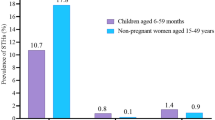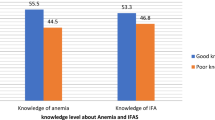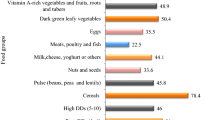Abstract
Objective:
To assess the potential impact of a national iron supplementation programme in rural Vietnam.
Methods:
The study included questionnaires, focus group discussions of pregnant women and key informant interviews, together with measurements of haemoglobin (Hb) and a stool examination for soil-transmitted helminths.
Results:
Iron supplementation significantly increased Hb concentration among participants in the second and third trimesters by 0.4 and 0.7 g/dl, respectively (P=0.017 and P<0.001). The risk of anaemia (Hb <10.0 g/dl) was increased significantly by hookworm infestation (P=0.041) and in summer season (P=0.001) and was decreased significantly by taking iron tablets (P=0.041).
Conclusions:
The results of this study show that an iron supplementation programme is beneficial as a part of a comprehensive anaemia programme for pregnant women in these communities. These results will be useful for developing improved iron-deficiency anaemia control programs for pregnant women.
This is a preview of subscription content, access via your institution
Access options
Subscribe to this journal
Receive 12 print issues and online access
$259.00 per year
only $21.58 per issue
Buy this article
- Purchase on Springer Link
- Instant access to full article PDF
Prices may be subject to local taxes which are calculated during checkout
Similar content being viewed by others
References
Abel R, Rajaratnam J, Kalaimani A, Kirubakaran S (2000). Can iron status be improved in each of the three trimesters? A community-based study. Eur J Clin Nutr 54, 490–493.
Afsana K, Shiga K, Ishizuka S, Hara H (2004). Reducing effect of ingesting tannic acid on the absorption of iron, but not of zinc, copper and manganese by rats. Biosci Biotechnol Biochem 68, 584–592.
Aikawa R, Jimba M, Khan NC, Zhao Y, Binns CW, Lee MK (2006a). Why do adult women in Vietnam take iron tablets? BMC Public Health 6, 144.
Aikawa R, Khan NC, Sasaki S, Binns CW (2006b). Risk factors for iron-deficiency anaemia among pregnant women living in rural Vietnam. Public Health Nutr 9, 443–448.
Allen HL, Casterline-Sabel J (2000). Prevalence and Causes of Nutritional Anemia. In: Ramakrishnan U (ed). Nutritional Anemia. CRC press: Florida, pp 7–22.
Allen L, Gillespie S (2001). What Works? A Review of the Efficacy and Effectiveness of Nutrition Interventions. Nutrition Policy Paper Series Vol. 19, Asian Development Bank (ADB) No.5. United Nation administration committee coordination, sub-committee on nutrition/ADB: Geneva/ Manila. pp 43–54.
Atukorala TM, de Silva LD, Dechering WH, Dassenaeike TS, Perera RS (1994). Evaluation of effectiveness of iron-folate supplementation and anthelminthic therapy against anemia in pregnancy – a study in the plantation sector of Sri Lanka. Am J Clin Nutr 60, 286–292.
Bach Kristensen M, Hels O, Morberg C, Marving J, Bugel S, Tetens I (2005). Pork meat increases iron absorption from a 5-day fully controlled diet when compared to a vegetarian diet with similar vitamin C and phytic acid content. Br J Nutr 94, 78–83.
Beard J (1995). One person's view of iron deficiency, development, and cognitive function. Am J Clin Nutr 62, 709–710.
Bondevik GT, Eskeland B, Ulvik RJ, Ulstein M, Lie RT, Schneede J et al. (2000). Anaemia in pregnancy: possible causes and risk factors in Nepali women. Eur J Clin Nutr 54, 3–8.
Brune M, Rossander L, Hallberg L (1989). Iron absorption and phenolic compounds: importance of different phenolic structures. Eur Clin Nutr 43, 547–557.
Christian P, Khatry SK, West Jr KP (2004). Antenatal anthelmintic treatment, birthweight, and infant survival in rural Nepal. Lancet 364, 981–983.
Department of Culture and Information (1999). Joint Report of the Government-Donor-NGO Working Group. Vietnam development report 2000. Attacking poverty. Department of Culture and Information: Hanoi.
Earl R, Wateki CE (1993). Iron deficient anemia, recommendation guidelines for the prevention, detection and management among US children and women of childbearing age. National Academy Press: Washington, DC.
English RM, Badcock JC, Giay T, Ngu T, Waters AM, Bennett SA (1997). Effect of nutrition improvement project on morbidity from infectious diseases in preschool children in Vietnam: comparison with control commune. BMJ 315, 1122–1125.
Galloway R, McGuire J (1994). Determinants of compliance with iron supplementation: supplies, side effects, or psychology? Soc Sci Med 39, 381–390.
General Statistics Office of Vietnam (2007): http://www.gso.gov.vn/default.aspx?tabid=503&ItemID=1841accessed on January 26, 2007.
Hallberg L (1985). The role of vitamin C in improving the critical iron balance situation in women. Int J Vitam Nutr Res Suppl 27, S177–S187.
Hallberg L (1987). Wheat fiber, phytates and iron absorption. Scand J Gastroenterol Suppl 129, S73–S79.
Hoang TQ (2001). National Nutrition Strategy 2001–2010. Medical Publishing House: Hanoi.
Johns WL, Lewis SM (1989). Primary health screening by haemoglobinometry in a tropical community. Bull World Health Organ 67, 627–633.
Khoi HH (2001). Report on Vietnam national anemia survey, 2000. National Institute of Nutrition: Hanoi.
Mason JB, Lotfi M, Dalmiya N, Sethuraman K, Deitchler M, Scott G et al. (2001). The micronutrient report, current progress and trends in the control of Vitamin A, iodine and iron deficiencies. Micronutrient Initiative: Ottawa.
Musaiger AO (2002). Iron deficiency anemia among children and pregnant women in the Arab Gulf countries: the need for action. Nutr Health 16, 161–171.
National Committee for Population, Family and Children Population and Family Health Project (2003). Demographic Health Survey 2002. General Statistical Office and ORC Macro: Hanoi.
National Institute of Nutrition (1995). Report of the national anemia and nutrition risk factor survey. National Institute of Nutrition: Hanoi.
Pawlowski ZS, Schad GA, Stott GJ (2002). Hookworm infection and anemia. Approaches to prevention and control. World Health Organization: Geneva.
Plasqui G, Westerterp KR (2004). Seasonal variation in total energy expenditure and physical activity in Dutch young adults. Obes Res 12, 688–694.
Preziosi P, Prual A, Galan P, Daouda H, Boureima H, Hercberg S (1997). Effect of iron supplementation on the iron status of pregnant women: consequences for newborns. Am J Clin Nutr 66, 1178–1182.
Roodenburg AJ (1995). Iron supplementation during pregnancy. Eur J Obstet Gynecol Reprod Biol 61, 65–71.
Sloan NL, Jordan E, Winikoff B (2002). Effects of iron supplementation on maternal hematologic status in pregnancy. Am J Public Health 92, 288–293.
Stoltzfus R, Dreyfuss M (1998). Guidelines for the Use of iron Supplements to Prevent and Treat Iron Deficiency Anemia. ILSI Press: Washington DC.
UNICEF/UNU/WHO (2001). Iron Deficiency Anaemia: Assessment, Prevention and Control. A Guide for Programme Managers. World Health Organization: Geneva.
Verhoeff FH, Brabin BJ, Chimsuku L, Kazembe P, Broadhead RL (1999). An analysis of the determinants of anaemia in pregnant women in rural Malawi-a basis for action. Ann Trop Med Parasitol 93, 119–133.
WHO (1992). The Prevalence of Anaemia in Women: A Tabulation of Available Information. WHO/NUT/MCM/92.2. World Health Organization: Geneva.
Yip R (1994). Iron deficiency: contemporary scientific issues and international programmatic approaches. J Nutr 124 (Suppl 8), S1479–S1490.
Acknowledgements
This study was financially supported by the Japanese Cooperation Agency (JICA) from February 2002 to February 2004. We acknowledge the assistance of people who worked in the field survey. We thank all the participants of this survey and the staff of commune health centres, district health service of Yen Thanh district, preventive medical centre of Nghe An province, Dr Thuy Hoa and Dr Nyguen Lan in National Institute of Nutrition for their assistance in the field survey.
Author information
Authors and Affiliations
Corresponding author
Additional information
Contributors: RA is a principle investigator, MJ is a co-investigator, KCN is a co-investigator in Vietnam, and CWB participated in the design of the study, statistic analysis and manuscript review. All the authors read and approved the final manuscript.
Rights and permissions
About this article
Cite this article
Aikawa, R., Jimba, M., Nguen, K. et al. Prenatal iron supplementation in rural Vietnam. Eur J Clin Nutr 62, 946–952 (2008). https://doi.org/10.1038/sj.ejcn.1602812
Received:
Revised:
Accepted:
Published:
Issue Date:
DOI: https://doi.org/10.1038/sj.ejcn.1602812



